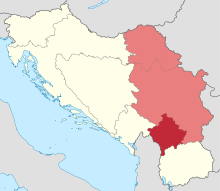
Yugoslavia was a country in Southeast and Central Europe that existed from 1918 to 1992.
This article includes information on the demographic history of Kosovo.

Serbia and Montenegro consisted of two republics, Serbia with its capital in Belgrade and Montenegro with its capital in Podgorica.
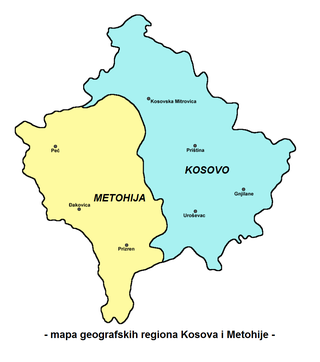
Metohija or Dukagjin is a large basin and the name of the region covering the southwestern part of Kosovo. The region covers 35% (3,891 km2) of Kosovo's total area. According to the 2011 census, the population of the region is 700,577.
The politics of Kosovo takes place in a framework of a multi-party parliamentary representative democratic republic, whereby the President (Presidenti) is the head of state and the Prime Minister (Kryeministri) the head of government. Parliamentary elections are held every four years, the most recent in 2021.

After a period of political and economic crisis in the 1980s, constituent republics of the Socialist Federal Republic of Yugoslavia split apart, but the unresolved issues caused a series of inter-ethnic Yugoslav Wars. The wars primarily affected Bosnia and Herzegovina, neighbouring parts of Croatia and, some years later, Kosovo.
The politics of Vojvodina function within the framework of the autonomous province of Vojvodina, Serbia. The province has a legislative assembly composed of 120 proportionally elected members, and a government composed of a president and cabinet ministers. The current political status of Vojvodina is regulated by the Statute of the Autonomous Province of Vojvodina from 2008.
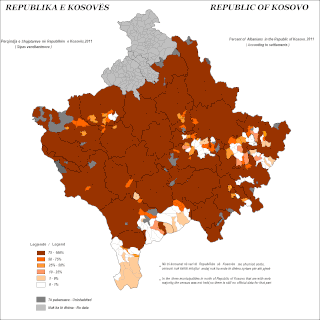
The Albanians of Kosovo, also commonly called Kosovo Albanians, Kosovan Albanians or Kosovars, constitute the largest ethnic group in Kosovo.

The Socialist Republic of Serbia, previously known as the People's Republic of Serbia, commonly abbreviated as Republic of Serbia, was one of the six constituent republics of the Socialist Federal Republic of Yugoslavia in what is now the modern day states of Serbia and the disputed territory of Kosovo. Its formation was initiated in 1941, and achieved in 1944–1946, when it was established as a federated republic within Yugoslavia. In that form, it lasted until the constitutional reforms from 1990 to 1992, when it was reconstituted, as the Republic of Serbia within the Federal Republic of Yugoslavia. It was the largest constituent republic of Yugoslavia, in terms of population and territory. Its capital, Belgrade, was also the federal capital of Yugoslavia.
The political status of Kosovo, also known as the Kosovo question, is the subject of a long-running political and territorial dispute between the Serbian government and the Government of Kosovo, stemming from the breakup of Yugoslavia (1991–92) and the ensuing Kosovo War (1998–99). In 1999, the administration of the Autonomous Province of Kosovo and Metohija was handed on an interim basis to the United Nations under the terms of UNSCR 1244 which ended the Kosovo conflict of that year. That resolution reaffirmed the territorial integrity of Serbia over Kosovo but required the UN administration to promote the establishment of 'substantial autonomy and self-government' for Kosovo pending a 'final settlement' for negotiation between the parties.

The current Constitution of the Republic of Serbia, also known as Mitrovdan Constitution was adopted in 2006, replacing the previous constitution dating from 1990. The adoption of new constitution became necessary in 2006 when Serbia became independent after Montenegro's secession and the dissolution of Serbia and Montenegro.

Fadil Hoxha was a Yugoslavian ethnic-Albanian communist revolutionary and politician from Kosovo. He was a member of the Communist Party and fought in the Yugoslav Partisans during World War II. After the war, he was the first President of the Executive Council of the Autonomous Region of Kosovo and Metohija (1945–1963) and later member of the Presidency of Yugoslavia (1974–1984).
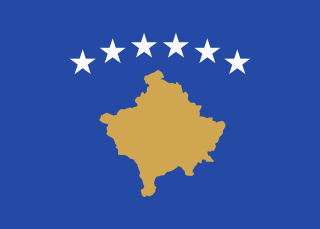
The flag of the Republic of Kosovo was adopted by the Assembly of the Republic of Kosovo immediately following the unilateral declaration of independence of Kosovo on 17 February 2008. The flag design emerged from an international competition, organized by the United Nations-backed Kosovo Unity Team, which attracted almost one thousand entries. The winning design was proposed by Muhamer Ibrahimi. It shows six white stars in an arc above a golden map of Kosovo, all on a blue field. The stars symbolize Kosovo's six major ethnic groups: Albanians, Serbs, Bosniaks, Turks, Romani, and Gorani.

The Autonomous Province of Kosovo and Metohija, commonly known as Kosovo and abbreviated to Kosmet or KiM, is an autonomous province defined by the Constitution of Serbia that occupies the southernmost part of Serbia. The territory is the subject of an ongoing political and territorial dispute between Republic of Serbia and the partially recognised Republic of Kosovo. Its claimed administrative capital and largest city is Pristina.

The League of Communists of Kosovo was the Kosovo branch of the League of Communists of Yugoslavia, the sole legal party of Yugoslavia from 1945 to 1990.

The Socialist Autonomous Province of Vojvodina was one of two autonomous provinces within the Socialist Republic of Serbia, in the former Socialist Federal Republic of Yugoslavia. The province is the direct predecessor to the modern-day Serbian Autonomous Province of Vojvodina.

Kosovo field is a large karst field, located in the middle part of Kosovo. It is mostly known for being the site of the Battle of Kosovo (1389) between the Balkan Alliance led by Lazar of Serbia and Ottoman armies led by Murad I, and many other battles.
The ethnic groups in Yugoslavia were grouped into constitutive peoples and minorities.
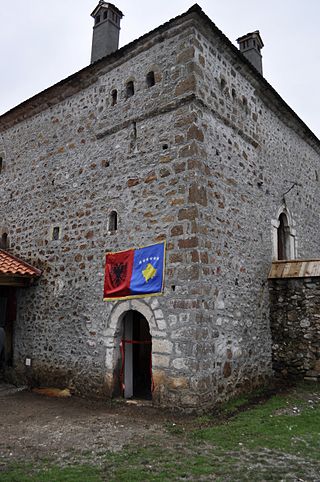
The Bujan Conference was a political assembly held between December 31st, 1943 and January 2nd, 1944 in Bujan, a village in the Highlands of Gjakova. It was attended by 49 delegates from the Communist Party of Albania and the Communist Party of Yugoslavia. The organization of the conference was fueled by the main political goal among Kosovo Albanians in that era which was self-determination and reunification of Kosovo with Albania.The main resolution voted in Bujan called for the unification of the Socialist Republic of Albania and Kosovo after the end of WWII. The resolution of Bujan was abandoned after German retreat from the Balkans. Kosovo remained part of Yugoslavia, as an autonomous region of SR Serbia. The first uprising against the new Yugoslav regime began in late 1944, a few weeks after Yugoslav leadership made it clear that the unification of Kosovo with Albania would not occur after the war.

United Nations Administered Kosovo refers to the period between 1999 and 2008 when the United Nations Interim Administration Mission in Kosovo was directly responsible for the governance of Kosovo. This period began on 10 June 1999 with the passing of United Nations Security Council Resolution 1244 and effectively ended on 17 February 2008 with the unilateral declaration of independence of Kosovo.
